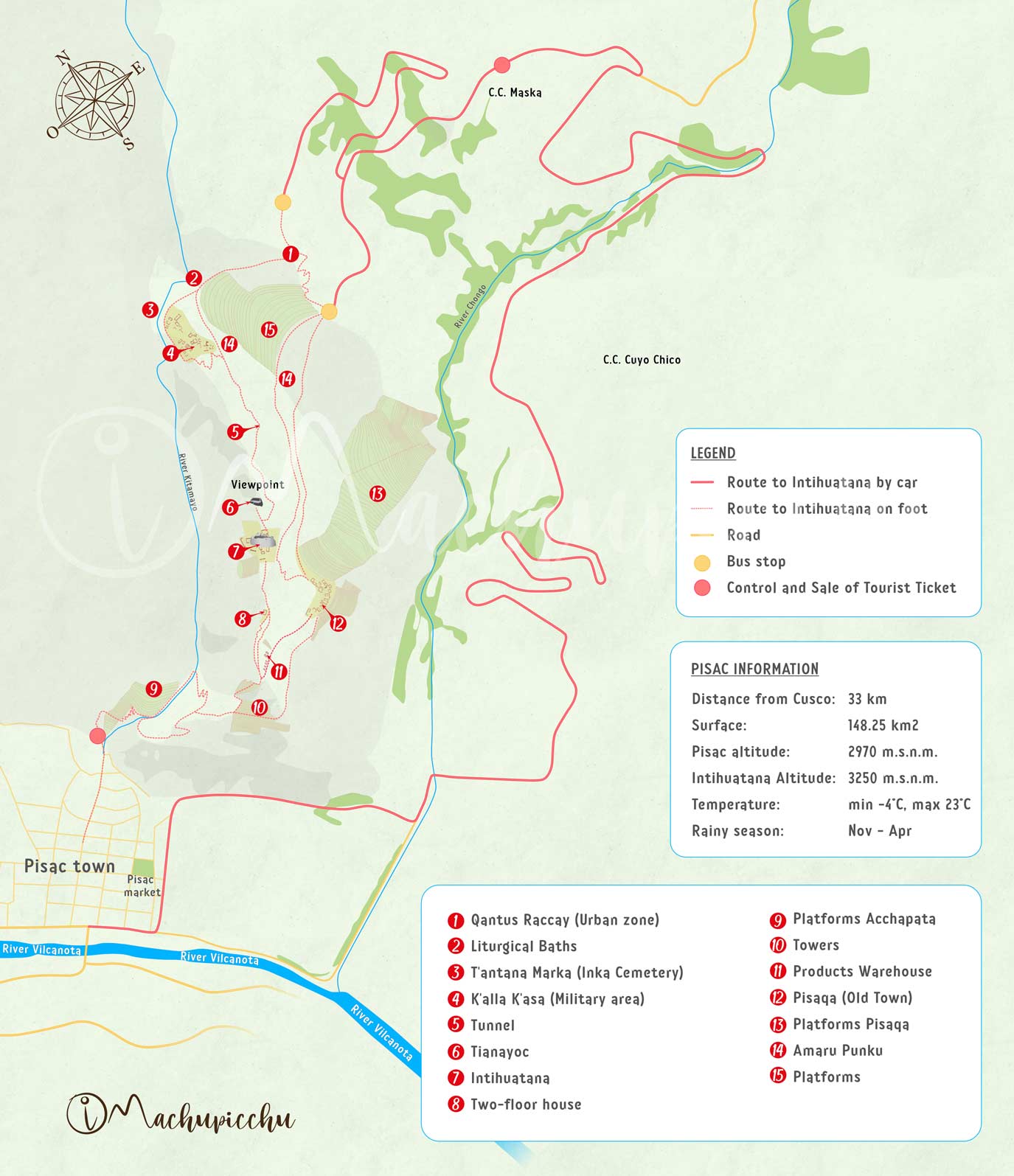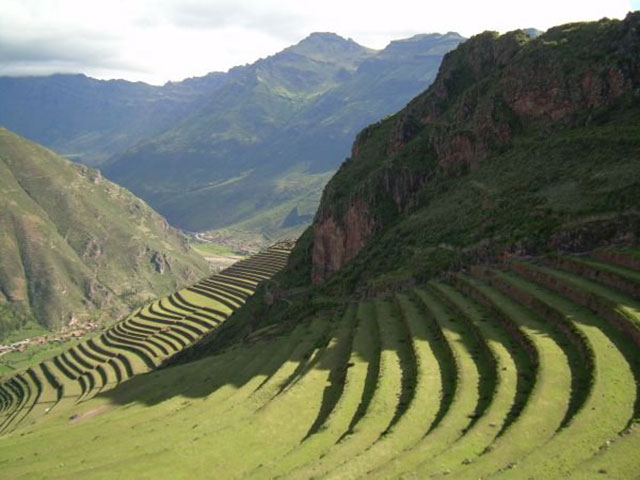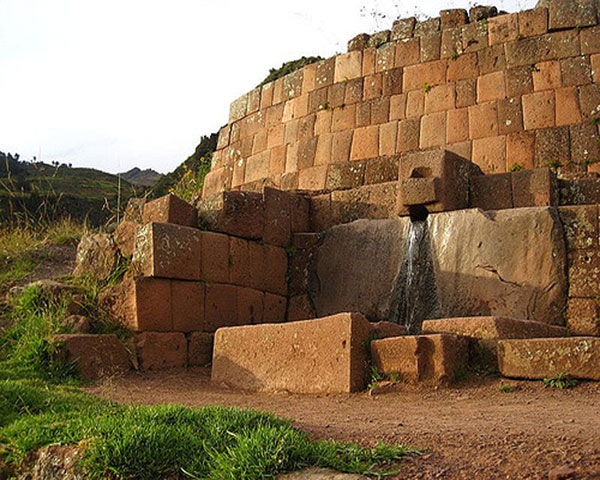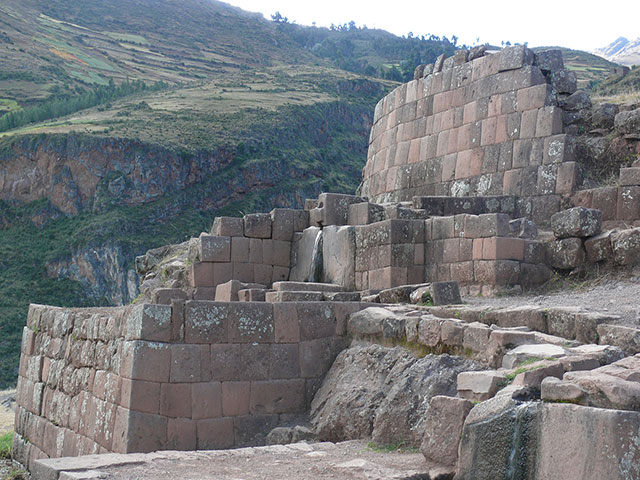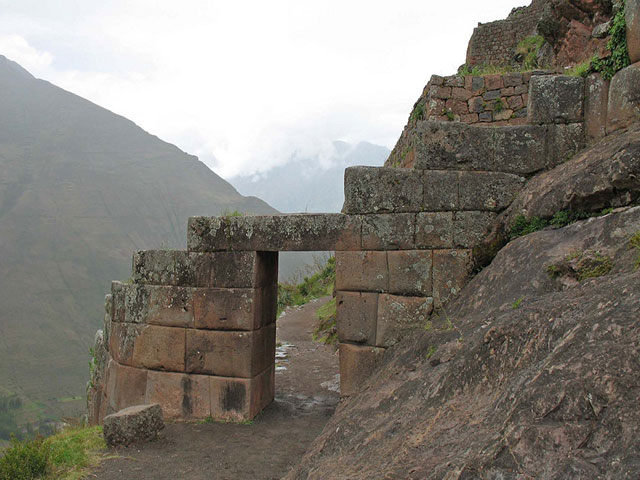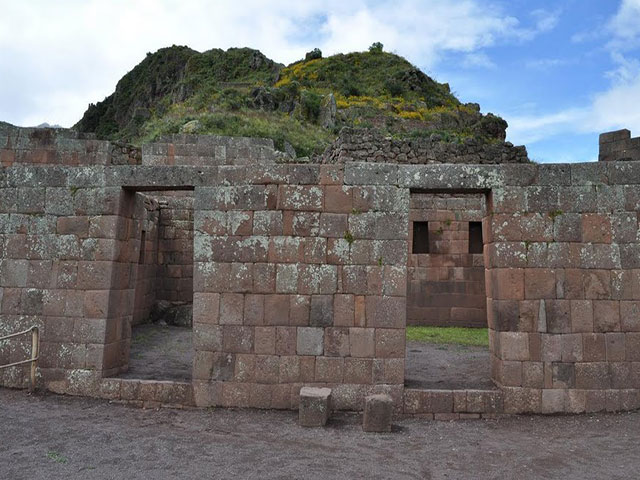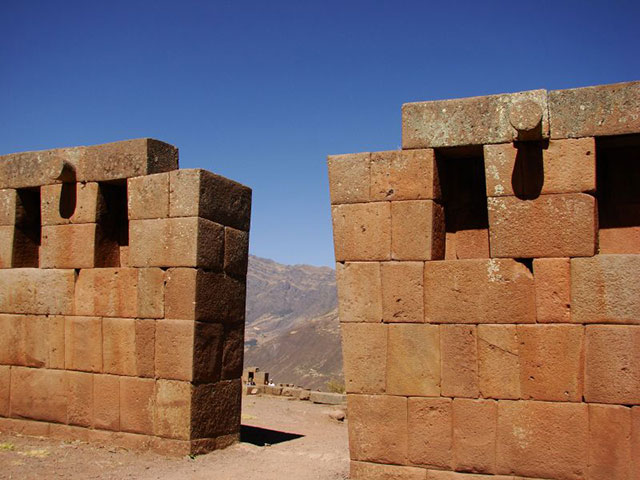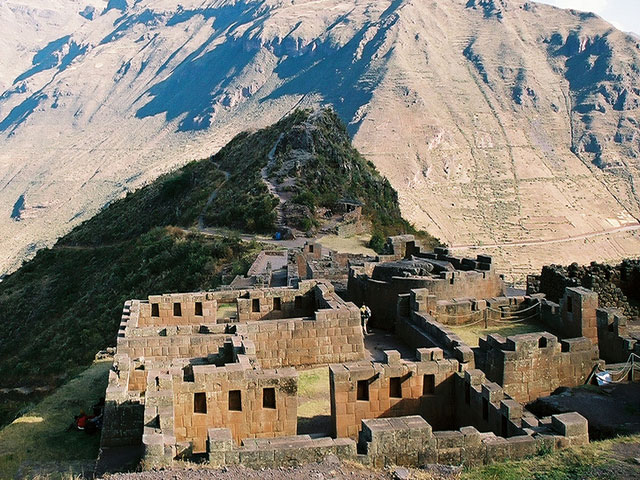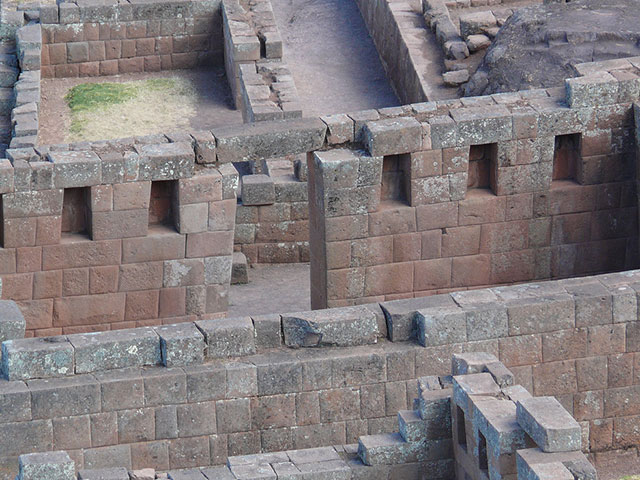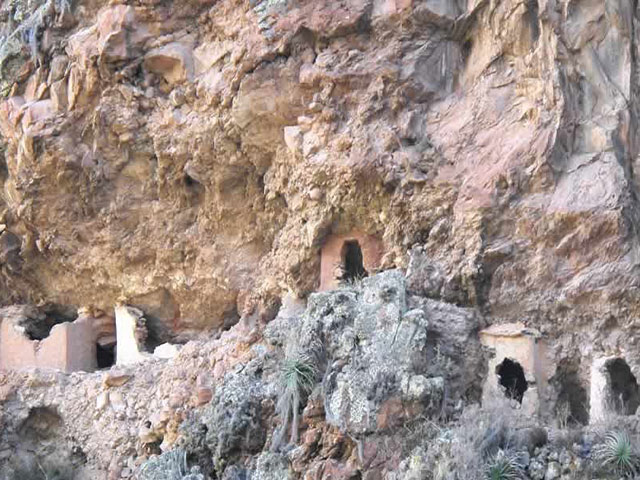The Inca site of Pisac: travel guide
If you travel to Machu Picchu in Cusco, Peru; Be sure to include the ruins of Pisac in your itinerary. This Inca archaeological site is one of the jewels of the Sacred Valley of the Incas. It has temples and palaces carved finely in stone.
How to know the ruins of Pisac? Know all the information you need.
- Pisac: location, height, climate
- The ruins of Pisac in the Sacred Valley of the Incas
- Pisac: tours, prices, schedules
- Other activities on the trip to Pisac
- Photo Gallery – Pisac Archaeological Park
- Questions and answers about the archaeological site of Pisac
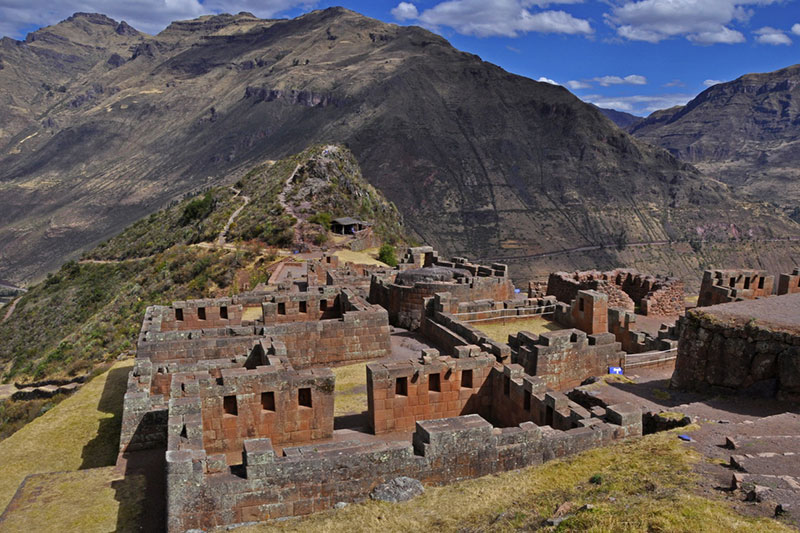
Pisac Archaeological Park
Pisac: location, height, climate
What is Pisac?
- Pisac is a town in Cusco famous for hosting the Inca archaeological site of the same name.
- Its ruins attract thousands of visitors who take a tour of the Sacred Valley of the Incas. It is recognized for its platform system and its carved stone enclosures.
- During the Inca period, Pisac was an important Inca citadel with an impressive system of platforms and terraces. During the colonial era, its temples were looted by the Spanish. Today it is one of the most important historical tourist attractions on the trip to Cusco.
- It is also one of the tourist attractions included in the Sacred Valley of the Incas tour in Cusco. It is estimated that around 200 visitors visit the archaeological site every day.
Where is it located?
- Pisac is located at the eastern end of the Sacred Valley of the Incas. The ruins of Pisac is one of the best Inca archaeological complexes in Peru.
- They are located on the road on the side of the mountain, just behind the town.
At what altitude is it located?
- The ruins of Pisac are located at 3,300 meters above sea level. The town is located at 2.974 meters above sea level.
His history
- The construction of Pisac was carried out during the government of Emperor Pachacutec in the 15th century, during a time of vertiginous territorial expansion.
- In the 16th century, after the arrival of the Spanish in Cusco, Pisac was invaded and its inhabitants fled. Its main monuments were damaged. The Inca cemetery was destroyed and looted.
- With the Toledo reforms (between 1532 and 1600), Pisac became a reduction of Indians. With the passing of time, the town settled on the slopes of the mountain where the Inca archaeological site is located.
- Today, Pisac is one of the most famous tourist attractions in the Sacred Valley of the Incas. The Inca archaeological site preserves many of its original structures in good condition.
How is the weather in Pisac?
- The climate in Pisac is mild most of the year. In the village, the climate varies from 2ºC. at 21ºC.
- There are 2 seasons: the dry season (from April to October) and the rainy season (from November to March). In the latter the rains occur more frequently. The days are mostly sunny and the nights are cold.
How to get to Pisac?
- Pisac is located 1 hour from the city of Cusco on the highway (34 kilometers). It is reached by the road that leads to Sacsayhuaman. Public transport buses are taken in Puputi Street in the Historic Center of Cusco.
- Once in the town of Pisac, you can walk (1 hour 30 minutes walk) or you can take public transport (30 minutes).
Myths and legends about Pisac
- The legend of Inkil Chumpi – In Pisac there is a rock formation called Inkil Chumpi. This summit has a legend behind it that tells the story of a princess, the only daughter of the governor of the Inca citadel of Pisac. The Inca governor decided that whoever marries his daughter should be able to build a bridge over the Vilcamayo River in just one night. The young Asto Rímac, the princess’s favorite, got down to work. Inkil Chumpi climbed a hill to ask for the favor of the gods, the ‘Apus’ or sacred mountains. They agree on the condition that they do not turn their eyes to see the work of Asto Rímac. She agrees, but unable to bear the uncertainty, she turns to look at the play. Then Asto Rímac was swept away by the waters of the river. She screams in despair, being turned to stone where the rock formation in Pisac currently is.
How to make the most of the entrance to Pisac?
The 1-day tour to the Sacred Valley of the Incas includes a visit to Pisac. The tour is in the company of a professional tour guide for approximately 1 hour. The circuit is enjoyable and includes a visit to the military zone, the sector of the platforms and the Amaru Punku. However, Pisac offers more than just seeing. For a more complete tour (2 hours on average) it is recommended to visit Pisac on your own. The Cusco Tourist Ticket allows entry and also access to the archaeological sites of Chinchero, Moray and Ollantaytambo.
The ruins of Pisac in the Sacred Valley of the Incas
What to see in Pisac?
In Pisac there are several tourist attractions:
- The town of Pisac – The town of Pisac is surrounded by beautiful mountains. There you can enjoy nature as well as its square and church.
- The market of Pisac – The traditional market of Pisac was a very important commercial place for centuries. Today, it is frequented by tourists, especially on Sundays.
- The ruins of Pisac – The most attractive tourist attraction of Pisac. It has important Inca remains as Machu Picchu as the Temple of the Sun.
How are the ruins in Pisac?
- In this enclosure, in addition to superimposed terraces, you will find ceremonial baths, a residential settlement and the largest Inca cemetery (the oldest in South America).
- Mountain below, you will find the complex of temples exquisitely carved in granite. There are ceremonial altars, water wells and the beautiful Temple of the Sun.
These are the archaeological sites of Pisac :
- Group of platforms of Acchapata – It is formed by 40 platforms that form an inverted triangle, that is to say, it will see the platform smaller, when it begins to ascend.
- Torreones or Pucaras – In total there are more than 20 towers. Some are attached to the mountain. The others are elevations of compact mass.
- Intiwatana neighborhood – It is the main neighborhood. It houses finely constructed temples and palaces. Its enclosures are larger compared to other neighborhoods. Here you can see the ‘Intiwatana’.
- Barrio de Tianayuc – Tianayuc translates “Que tiene asiento”. It is known as a kind of sofa for 2 people made of stone, with backrest and elbow pads.
- K’alla Q’asa neighborhood – Here you will see chambers, towers, and a tunnel 3 meters long. This neighborhood is built next to impressive ravines.
- Pisaq’a neighborhood – This neighborhood has a semicircular shape, in harmony with the circumference of the mountain, here you can see more than 20 enclosures, built in amazing order.
- Qanchis Raqay Quarter – This neighborhood is a kind of checkpoint, guarding the northeastern side of the city of Pisac.
The tourist circuit through the Inca ruins of Pisac
- The tourist circuit through the ruins of Pisac does not follow a strict route. However, there are some roads closed to the public due to the danger of landslides.
- Most tourists follow the following circuit: the main viewpoint (Qantus Raccay), the platform sector (liturgical baths), the Inca cemetery sector, the military zone, the amaru punku and the return to the Qantus Raccay sector.
- Older adults or people who do not want to walk too much can appreciate the beautiful landscapes from a viewpoint.
Pisac and Machu Picchu: differences and similarities
| Archaeological site of Pisac | Machupicchu archaeological site | |
| Location | 34 kilometers by road from the city of Cusco | 120 kilometers by bus and train from the city of Cusco. |
| Altitude | 2,972 masl | 2,430 masl |
| Function | Inca citadel, religious center and surveillance post | Inca citadel, religious center and surveillance post |
| Extensión | 148 square kilometers | 530 meters long by 200 meters wide |
| Temples | Intihuatana, Amaru Punku | Intihuatana, Temple of the Sun, Temple of the 3 Windows, Sacred Rock |
| buildings | Temples, smaller enclosures, royal houses and platforms that make up more than 400 buildings | Temples, smaller enclosures, royal houses that make up more than 150 buildings |
| Price of admission | Cusco Tourist Ticket (70 soles for foreigners) – Also includes Moray, Ollantaytambo and Chinchero | Entrance to Machupicchu Only (152 soles for foreigners). |
| Visiting hours | From Monday to Sunday from 7 am to 6 pm. | From Monday to Sunday from 6 am to 5 pm. |
| Circuit time | Longest circuit 2 hours approximately. | Circuit 2 (complete) 2 hours 30 minutes approximately. |
Pisac: tours, prices, schedules
How to visit Pisac?
You can visit Pisac in 3 ways:
- Hiring the services of a tour to the Sacred Valley of the Incas, which includes the entrance to the ruins of Pisac.
- Buying the Tourist Ticket of Cusco in its offices located in the AV. El Sol. I can buy the full or partial ticket.
- Buying the entrance to the door of the same archaeological site of Pisac.
Pisac, temples, enclosures and Inca cemetery!
The Inca city of Pisac is huge. It has huge platforms where the Incas mainly cultivated potatoes and corn. It had enclosures for the common population and for the Inca nobility. It is divided into various neighborhoods such as Tianayuc, K'alla Q'asa, Pisaq'a, Qantu Raqay and more.
How much does the entrance to Pisac cost?
The Cusco Tourist Ticket is the most economical way to visit Pisac because it also includes many other archaeological sites:
- General tourist ticket: S/. 130
- Partial tourist ticket: S/. 70
What are the opening hours in Pisac?
From 7 am to 6 pm It serves every day of the week.
When is the best time to go to Pisac?
The dry season (from April to October) is the best time to visit Pisac. During those months there is less chance of rains so the tour is easier. It is recommended to visit in the early hours of the morning.
Tips for visiting Pisac
- Bring a bottle of water before and during the trek.
- It is advisable to use hiking shoes. That way you will avoid kinks and accidents.
- Take rain poncho with you. It is not known when the fluvial precipitations will happen.
- The day is hot so it is advisable to wear a hat, sunscreen and sunglasses.
- The best way to understand Pisac is with the company of a tour guide. The tours include this service. Another option is to hire one at the entrance door.
The tour to the archaeological site of Pisac
- The 1-day tour to the Sacred Valley of the Incas includes a visit to the archaeological site of Pisac. In addition, it offers a visit to the archaeological site of Ollantaytambo and Chinchero. The services included in the tour are: pick up from the hotel (in Cusco), round trip tourist transportation, professional tour guide and buffet lunch in Urubamba.
- In addition, there is another tour called the VIP Sacred Valley, which, in addition to the visit to Pisac, Chinchero and Ollantaytambo, includes a tour of the circular platforms of Moray and the Salineras de Maras.
- Another way to visit Pisac with a tour is to choose the ‘Sacred Valley + Machu Picchu 2 days’ tour. This service includes a visit to Pisac and Ollantaytambo (also a buffet lunch in Urubamba). From Ollantaytambo take the train that leads to the town of Aguas Calientes. The visit to Machu Picchu takes place on the second day. That is, this tour does not offer a visit to Chinchero.
- Tours to the Sacred Valley of the Incas -include Pisac- have a cost between 60 to 90 US dollars.
Budget to visit Pisac on your own
| Service | Price in US dollars |
| Public transportation from Cusco to Pisac | 5 Peruvian soles (2 US dollars) |
| Taxi transportation from the town of Pisac to the archaeological site | 10 Peruvian soles (3 US dollars) |
| Entrance ticket to Pisac* | 70 soles for foreigners (20 US dollars) / 40 soles for Peruvians (12 US dollars) |
| Professional guide in Pisac | 15 dollars per tourist |
| Transportation by taxi from the archaeological site to the town of Pisac | 10 Peruvian soles (3 US dollars) |
| Public transportation from Pisac to Cusco | 5 Peruvian soles (2 US dollars) |
| Total visit Cusco – Pisac of 1 day | 45 USD. |
*The Cusco Tourist Ticket also includes the entrance to Moray, Chinchero and Ollantaytambo.
Other activities on the trip to Pisac
Pisac market
The archaeological site of Pisac is 9 kilometers by road from the town of Pisac. This town is famous for its beautiful Andean landscapes, the traditions of its inhabitants, and also for its craft market, which offers a wide variety of products including food, chocolates, jewelry, and clothing made of alpaca. On Sundays the market grows with the arrival of residents from the different nearby communities. Thus, touring the market is a very striking cultural experience full of color. Pisac is not only famous for its archaeological site but also for its jewelry workshops, for its textile centers and everything can be found in its fair market.
Trek to the archaeological site of Pisac
The town of Pisac is located 3.6 kilometers from the archaeological site of Pisac. This distance seems manageable for most tourists. However, the route is mostly uphill through hundreds of stone steps. In total, the visitor will ascend 454 meters on foot (the town of Pisac is at 2,973 masl while the archaeological site is at 3,427 masl). This route can take between 2 to 3 hours (or less), depending on the physical resistance of the visitor. The good thing is that the route is free for everyone. The starting point is in the heart of the town, just a few steps from the food market. It is recommended to bring a hat, sunscreen, comfortable clothes for the walk, as well as sturdy shoes. Upon arrival at the archaeological site, the tourist must show their entrance ticket (Tourist Ticket of Cusco).
Pisac Botanical Garden
The Pisac Botanical Garden is a green space in the heart of the town of Pisac in the Sacred Valley of the Incas. There you can see different types of plants such as orchids, potato flowers, kantu flowers, as well as a collection of Andean cacti, the most important sample of this species in Peru. The museum also exhibits a collection of Andean seeds, a sample of plants, insects, butterflies, and minerals. The architect of this project is the botanist and researcher from Cusco Felipe Marín Moreno. The museum is located a few steps from the main square of the town of Pisac (33 kilometers from the city of Cusco). Visiting hours are from Monday to Sunday from 9 in the morning until 5 in the afternoon. The cost of the visit is only 6 Peruvian soles, about 2 US dollars.
Photo gallery – Archaeological Park of Pisac
Questions and answers about the archaeological site of Pisac
How much does the trip from Cusco to Pisac cost on my own?
If you want to go to Pisac on your own you must take a public transport (minivan) on Puputi street, located just 15 minutes from the city center. This trip has a cost of 5 Peruvian soles (less than 2 dollars) and takes approximately 1 hour.
Can I hire a tour guide at the entrance door?
Touring Pisac with a tour guide is optional. At the same entrance door you can hire one, either in shared (group) or private (personal) service.
Can I walk up from the town of Pisac to the archaeological site?
Yes, the walk is arduous and begins near the main square of the town. It travels about 3.6 kilometers and it can take 1 hour 30 minutes, approximately.
Where to buy the Cusco Tourist Ticket?
You can buy the Cusco Tourist Ticket on Avenida El Sol 185, a few steps from the city’s Plaza de Armas.
Where to buy a tour to Pisac?
You can purchase a tour to Pisac at any Cusco tourism agency, either in person or online. We recommend looking for a serious agency. You can read recommendations or criticisms in online forums.
How long does it take to go through the entire archaeological site?
The archaeological site of Pisac is huge. Going through all its neighborhoods, buildings and roads can take 2 hours or even more.
Is the visit dangerous?
No, the archaeological site of Pisac has well-marked paths with notices for tourists. The park rangers pass through the buildings at all times.
Is Pisac open all year?
Yes, the archaeological site remains open to tourists every day of the year except for emergencies (natural disasters, strikes, etc).
Advice from people who have been there
 By: Of: Johana V.
By: Of: Johana V.“Excellent information“
“I found this article very useful to visit Cusco and stay in Pisac, a really beautiful place close to the nature of the Sacred Valley, with excellent views. Thanks to this page for the very detailed information“
By Ticket Machu Picchu – Last updated, August 15, 2024
